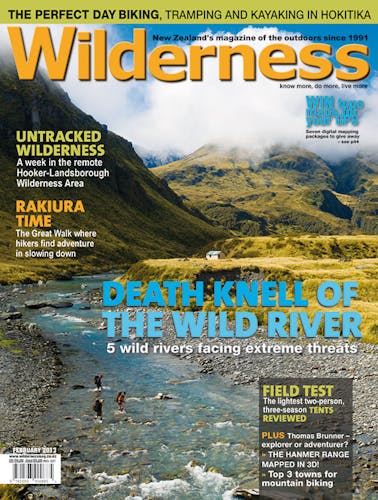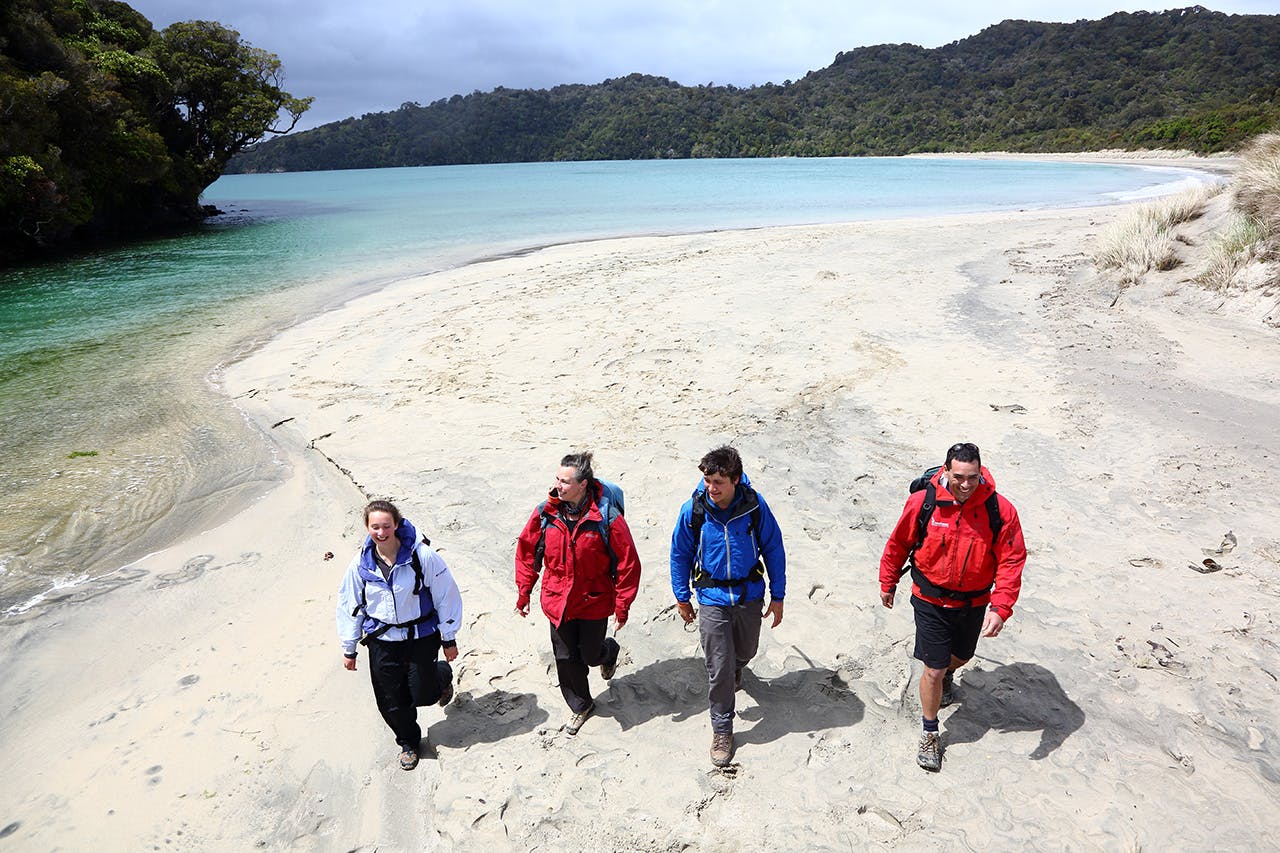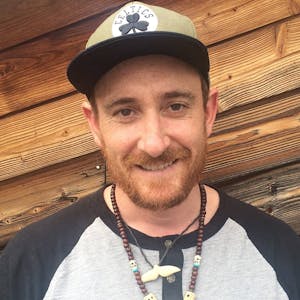Josh Gale walks Rakiura Track on its 10th anniversary and finds much to celebrate, including an excuse to become as lazy and slow as he likes on the island of tranquillity
Standing alone in near total darkness I discern a suspicious shape only meters away.
It’s just a dark smudge in the overall blackness, but it makes my heart leap: maybe it’s a great spotted kiwi.
It was my first night on Stewart Island’s Rakiura Track. Along with others staying at Port William Hut, I had been looking for kiwi since nightfall.
I back away and adjust my headlamp to low and switch it on. Two red orbs stare back at me and a large possum ambles off into the bush. Soon after, I’m off to my sleeping bag, disappointed not to have spotted a kiwi in the wild.
Entries in the hut book recounted sightings others had made just the night before. Flicking through the book’s pages, I read many other ecstatic accounts.
It’s not surprising really; Stewart Island/Rakiura is home to between 16,000 and 20,000 kiwi and only about 450 humans. And based on long term monitoring work at Mason Bay and Port Adventure, it appears the kiwi population is stable.
With those kinds of numbers, my time on Rakiura was going to be my best chance to see New Zealand’s national icon in the wild for the first time.
I had arrived on the island two days earlier, to walk New Zealand’s youngest Great Walk, the Rakiura Track, on its 10th anniversary. Shortly after arriving I met the Department of Conservation’s Di Morris at the visitor centre in Halfmoon Bay.
While we talked – or rather I babbled at my usual 100km/h – I became aware she was giving me one of two possible looks: the one suggesting you’re being a dick or, even worse, the look that suggests you’re nuts. She put a calming hand on my arm. “You need to slow down and relax, Josh,” Morris advised. “You’re on Stewart Island, just enjoy yourself.”
As I walked back to my room at Kaka Retreat, I thought about her comment and realised I was still in a city state-of-mind.
By the time I reached my room, I was feeling strangely exhausted – as though the island’s tranquillity was allowing my city-borne weariness to surface. I drank a complimentary mini-bottle of Hokonui Whisky and with none of the usual techno-distractions lay on my bed listening to kaka squawking before falling into a deep sleep.
The next morning, I made an empowering decision about the next few days: I was going to slow down; switch gears to island time.
So much about Stewart Island took me by surprise. I was expecting a cold, windswept, desolate island, but flying in from Invercargill I was astonished to see golden beaches and the kind of clear, turquoise water you’d normally associate with a Pacific island’s tourism brochure, not the last stop before Antarctica.
I was so impressed by the beaches and coastal vistas I decided to walk from Oban to the start of Rakiura Track via Horseshoe Point Track, adding about 5km to the day’s walk. Morris encouraged me, explaining all of Stewart Island, including its residential areas, is rich in history and natural beauty. DOC manages 92 per cent of the 175,000ha island and the rest – including six per cent that is owned by Maori – is more park-like than residential. Everywhere kaka, tui and bellbirds screech, burble and chatter.
By the time I reached the start of the Rakiura Track and sat down for lunch, I was feeling reinvigorated. The city was starting to wear off.
I passed through the iconic chain link sculpture at Lee Bay which disappears into the sea and symbolises Stewart Island’s mythological link to the South Island as the anchor to Maui’s canoe. Bluff has the same sculpture, signifying where the chain returns to the mainland waka.
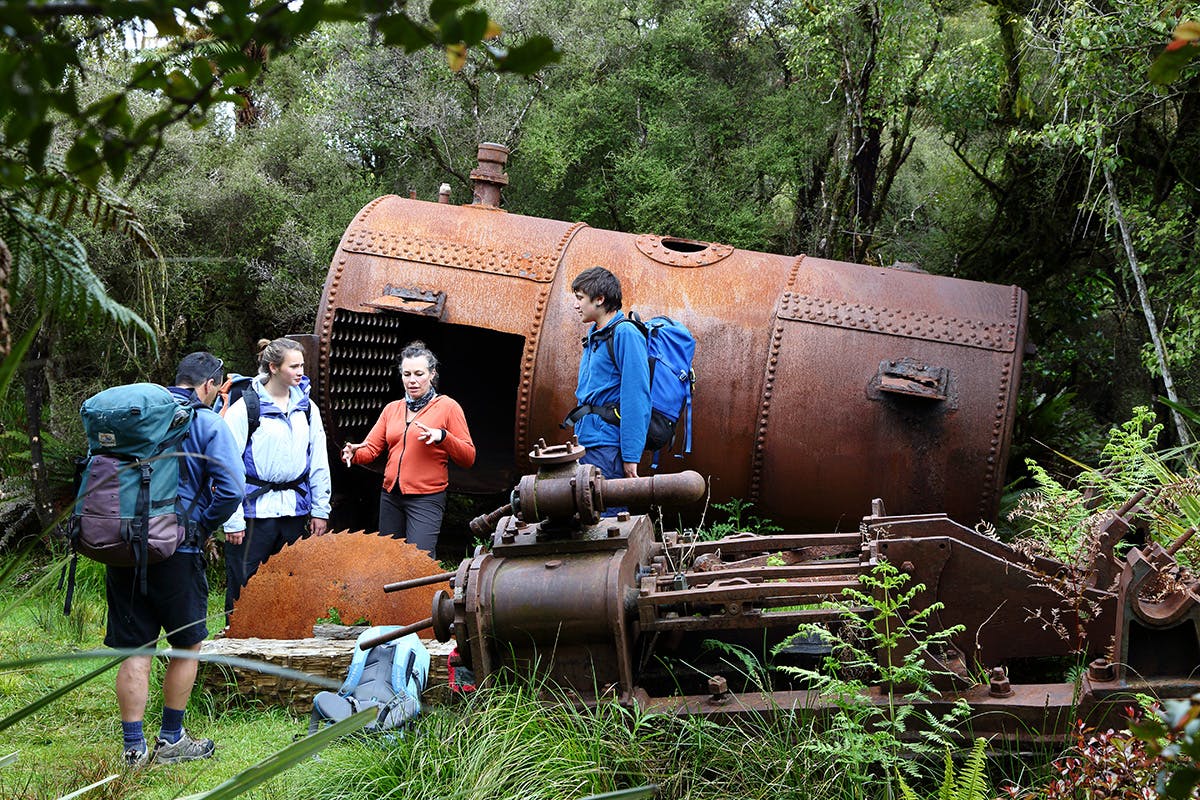
A dilapidated boiler reminds walkers of Rakiura’s boom and bust past. Photo: Venture Southland
I stopped to take photos of small bronze plates imbedded in the path with gentle reminders about the importance of wild, pristine places like Stewart Island. In a way, it’s lucky it remains so.
In the mid-1770s, Captain James Cook reported the island had seals and timber in commercial abundance.
After that it was all on: sealing, whaling, timbering, fishing, farming and gold mining have all done their best to extract a profit from the island. But as locals like to point out, each industry either failed or boomed and went bust.
Now it’s tourism’s day in the sun.
In 2001, according to Statistics New Zealand, 99 Stewart Island residents were employed by the tourism industry. In 2006, the number was 126, more than a quarter of the population.
The total number of people employed by other industries combined, including fishing, decreased by seven per cent between 2001 and 2006.
A new law allowing Southland District Council to charge visitors a $5 levy when they arrive on the island is also evidence of the increasing importance of tourism.
About 40,000 people visit Stewart Island every year and the impact on its infrastructure has been too much for the island’s small population to fund on its own. The $5 levy should generate enough revenue to cover vital infrastructure maintenance which in turn will encourage more tourists to the island who might otherwise have been put off by a lack of services.
As I walked on, it was easy to see why tourism is increasing. I caught myself involuntarily saying ‘damn’ as I came around corner after corner and found one bay after another of paralysing beauty. I had to force myself to move on.
Gareth Morgan also sees the island’s potential. The entrepreneur and environmental campaigner visited in October last year, met with the community and proposed making it New Zealand’s first predator free island with humans inhabiting it.
The Morgan Foundation has been working with DOC on New Zealand’s sub-Antarctic islands and the Million Dollar Mouse project which aims to eradicate mice from New Zealand’s Antipodes Islands.
Morgan ran a yes or no vote to gauge whether locals support the idea and an overwhelming majority voted yes.
The next step, Morgan says, is investigating how to achieve it.
After an easy stroll along the coast from Lee Bay, occasionally ducking into the island’s forest, with its understory of crown fern, the long, empty Maori Bay appeared. There’s a DOC cooking shelter and campground at the south end and if I’d had a tent I would have camped there and gone on to Port William Hut the following day.
As I carried on down the white sand beach, I noticed a woman walking in the distance and shortly, after crossing a swingbridge at the end of the beach, I passed her and her male companion idling in the small estuary with clear, rust coloured water.
The place was so still and untouched it seemed weird to see other people.
I regretted saying hello to them. It was like dropping a rock into a still pond; the sound waves breaking a perfect peace. They acknowledged me, but nothing more. My greeting was just an unnecessary noise and the look the man gave me said as much.
Embarrassed, I pushed on and with each footstep my mind became quieter.
However, that changed when I reached Port William Hut and met Terry and Di Anderson, an older couple from One Tree Hill in Auckland.
They’d lived in Dubai for 15 years, travelled extensively and, as a result, have an understanding of geopolitics rare among New Zealanders.
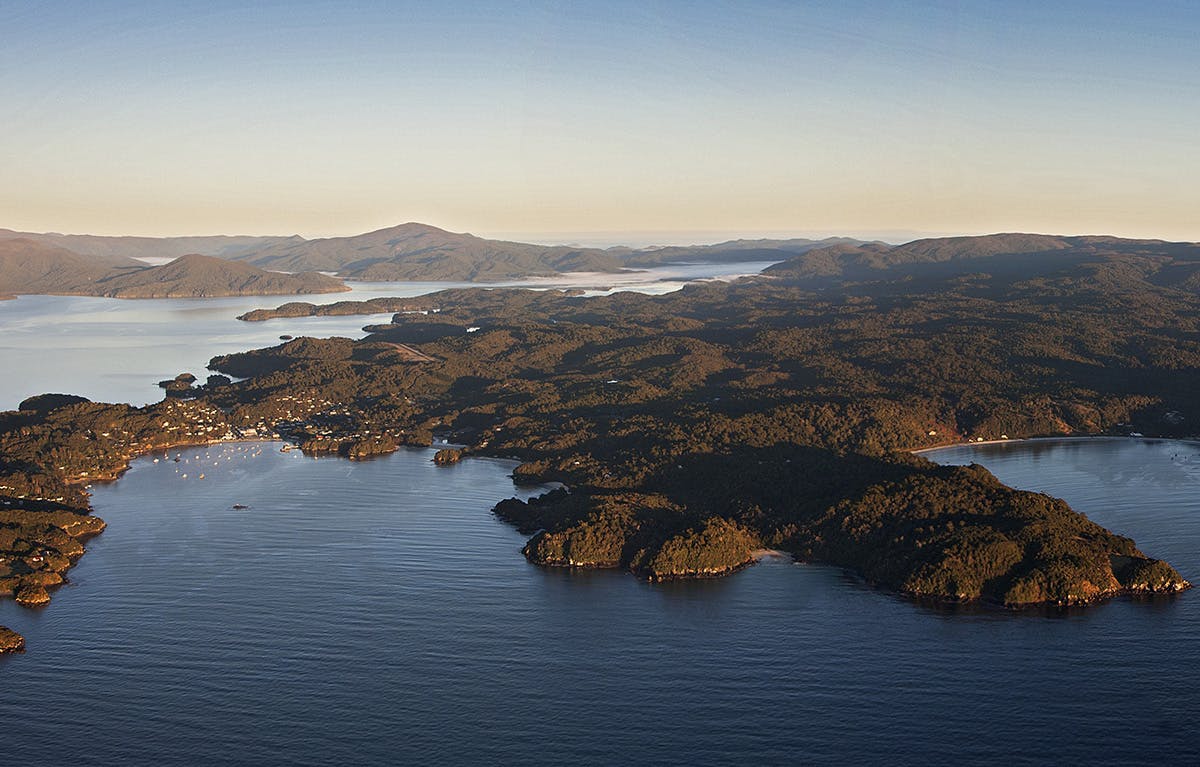
Around 92 per cent of Stewart Island’s 175,000ha is managed by DOC. Photo: Jo Price
Before I knew it, we were drinking whisky and debating Uncle Sam’s recent activities. This was brought into comic relief by a group of Texans who broke out their Bible and said grace before dinner.
We sipped our whisky and tried not to giggle.
The next morning I slept in, had a long breakfast and drank a few cups of tea whilst reading the hut book. I tried to count how many Kiwis had stayed at the hut compared to people from other nations.
Since DOC introduced the booking system for the Rakiura Great Walk in October 2010, occupancy in the two huts – Port William and North Arm – has increased by 15 per cent and DOC says more than half those walking the track, between then and November 2012, were New Zealanders. After finishing my count, this seems accurate; Kiwis were first by a long way, followed by Americans, English, Germans, French and Europeans generally.
A couple from Gore wrote in the hut book: “Harder than it was 19 years ago”. I assume they mean because they aren’t spring chickens anymore because the track itself has become easier over the last few years.
Rakiura Track once had the reputation of being New Zealand’s worst Great Walk because long sections of the track consisted of ankle deep mud. But since 2007, DOC has worked hard to change this. Large sections of worn-out boardwalk have been removed and much of the track has been realigned and hardened with gravel.
What was once a muddy bog in sections is now a gravel footpath nearly the entire way around. This must have cost DOC a fortune. Stewart Island visitor and historic assets manager Dale Chittenden dodged my questions about cost, but did say upgrade work is higher than on the mainland because of the island’s peaty soils and the cost of transporting materials there.
“I heard someone say you can build a road cheaper on the mainland than you can build a track on Stewart Island,” Chittenden says. “I haven’t tested to see if this is actual fact but I sure can believe it.
“The cost to upgrade a hut works out to be around $3000m² and to gravel a track it costs $37 a metre.”
While DOC’s track upgrades will be an incentive for some, they will also turn off people who want a wilder experience.
I found the gravel path monotonous at times and would have preferred more natural ground, even if there was a bit of mud.
But DOC can’t please all the people all of the time and for those wanting a walk on the wild side, the park’s 10-day North-West Circuit is as muddy and demanding as it gets.
Whatever your preference, the new gravel track does open it up to all sorts of people. This, and the four to five hour walking on each of the three days makes it an ideal tramp for young families and older people. Di Anderson, for example, has had both of her hips replaced in the last three years, as well as one of her knees. She said if DOC hadn’t upgraded the track she wouldn’t have been able to join Terry on the trip.
Rakiura Track is also perfect for people wanting an easier, more relaxed experience. Not all multi-day tramps have to be hard; there is a time and a place for slow and lazy.
It was 11am by the time I left Port William Hut. I got as far as the beach 30m down the track and decided I needed a break. I sat down on the creamy-coloured sand and listened to the birds and the high tide lapping at my feet.
It seemed wrong to move on without trying to fully absorb the place. The lush forest growing at the edge of the beach, the isolation and solitude made the worries of humanity trivial. It was one of those places that no matter how long you stay, it’s hard to feel like you’ve been there long enough.
I decided to stop a bit longer. I stretched out on the beach and fell asleep.
When I woke an hour later, I thought of all the Kiwis who travel to Fiji for their holidays – their money propping up a military dictatorship – when they could be enjoying this pristine slice of New Zealand. Give me Stewart Island any day. Reluctantly, I pulled on my pack and carried on.
The walk from Port William to North Arm Hut is more challenging than the first day. It has more elevation gain and is 13km, rather than 8.1km. The third day, however, is even easier than the first.
Another criticism made of Rakiura Track is after the first day the scenery from Port William to the end becomes repetitive. Especially, on the second day, from Port William to North Arm, there are no coastal or open views.
But having walked the track, I feel this criticism says more about the people who make it than it does about the track. Some people, it seems, are easily bored.
Sure, it’s all forest, but it’s one of the most impressive in the country. Huge rimu are in abundance and kaka, bellbird, tui, tomtit and other birds fill the forest with song. In one gulley a dozen bellbirds performed a concert more stirring than any human equivalent I’ve ever heard.
By the time I reached North Arm Hut the weather had packed in. I wasn’t keen enough to see a kiwi to venture out in the rain, but in the morning I wished I had.
While I was having breakfast one of the Texans said she saw a kiwi with two chicks near the toilets.
“I heard many Kiwis haven’t even seen a kiwi in the wild,” she said, elated. “But I have now.”
I didn’t get lucky this time – maybe that’s what you get for laughing at prayer time.





